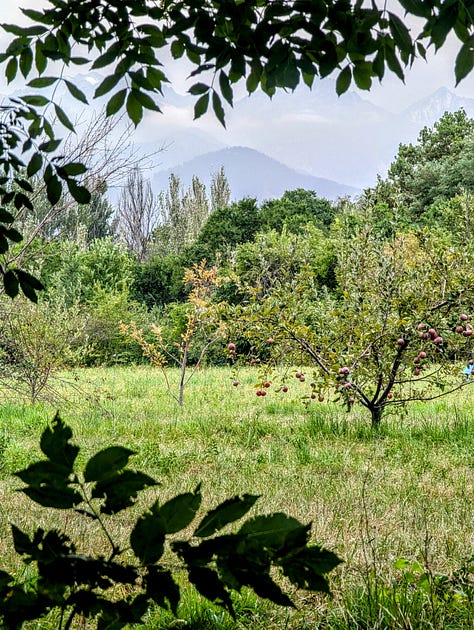The Real Big Apple: Tracing the Botanical Origins of the World's Most Foundational Fruit
Every apple you've eaten originates in the Tian Shan mountains near Almaty, Kazakhstan — the first and now perhaps last frontier for the ancestor of the Garden of Eden's forbidden fruit.
📍 Almaty, Kazakhstan
Archeology meets botany in an extraordinarily crisp way in Almaty, Kazakhstan. In this city, apples were born. In a world where apples are so ubiquitous that they have permeated our language and culture — where we advise “an apple a day,” extol “the apple of my eye,” and compare “apples and oranges” — the idea that all these fruits have a singular botanical origin seemed like a revelation.



Today’s apples that we take for granted—Granny Smith (first bred in New South Wales, Australia in 1868), McIntosh (the 1796 discovery of John McIntosh of Ontario, Canada), Fuji (first cultivated in Japan in the 1930s), and thousands of other varieties—can all trace their lineage back to the Malus sieversii that still grows in the mountains of southern Kazakhstan. My search for the wild ancestor of every apple we eat today (that is, except for the European crabapple) took me from the city, into the surrounding Tian Shan mountains, where the largest, most diverse, and perhaps last population of the Malus sieversii remains. It was here in 1929 that Russian scientist Nikolai Vavilov first traced the original apple genome.
The apples hanging from the wild trees’ branches were varied in size and not particularly sweet by modern standards. Yet, they possessed an undeniable charm, a raw and unrefined beauty that spoke of their ancient origins. It was easy to imagine how early humans, thousands of years ago, might have been drawn to these fruits, selecting the best ones to cultivate, and in doing so, unwittingly laying the foundation for the 7,500 Malus domestica varieties we know today. That’s quite a botanical legacy for these remote Kazakh forests to leave.
From the Tian Shan foothills, bears, Silk Road traders, and other mammals spread apple seeds. They did so both unintentionally, through defecation or tossing apple cores along roadsides, and deliberately, by planting seeds from China, to Persia and Caucasia, to the Mediterranean and Europe. Apples, commonplace in Kazakhstan and neighboring Silk Road countries since 8,000 B.C., didn’t reach the Western Hemisphere until the year 1692, when the Boston Bay Company placed an order for apple seeds from then colonial Europe. By the turn of the 20th century, the Malus sieversii had spawned 650+ different varieties.
Almaty might be the true and literal “Big Apple.” The city derives its name from the Kazakh word for apple, “alma,” and its former name, Alma-Ata, means “Father of Apples.” Even today, the importance of apples to this region is evident in its sprawling apple orchards, apple-themed sculptures, and an annual autumn festival that celebrates the fruit’s cultural and historical significance.






A local botanist explained to me that each wild apple tree is unique: one might be more resistant to drought, while another might have a natural resistance to pests. It’s this diversity that makes the wild Malus sieversii so valuable. In essence, these trees are a living gene bank, a resource for breeding new apple varieties with various strengths: taste, texture and resilience. Their flavor varies from sweet to sour depending on the bees that pollinate them; they also diverge in size and shape, from flatter to conical, as well as color, from golden yellow to solid red.
The apples we eat today are the result of thousands of years of human intervention cashing in on the Malus sieversii’s bank of genetic possibilities. By comparison, the gene pool of cultivated Malus domestica varieties is shallow, and that means a single disease can wipe out thousands of trees in weeks. Yet, here in the Kazakh mountains, the original apples still thrive, untouched. It’s a spectacular thought: something as simple and familiar as an apple could have a singular ancestor rooted in this remote corner of the world.
One of the highlights of my journey was encountering the famous Aport apple on a visit to the Green Market, the largest in Almaty. This large, flavorful variety was once a symbol of the city and a prized export before its cultivation declined in the 20th century. The Alma Project, a partnership between the Kazakh National Agrarian Research University and the German Federal Foundation for the Environment, aims to put Almaty Aport apples on the map as a Kazakh brand, similar to how Parmesan cheese hails from Italy’s Parma province and champagne from France’s Champagne region. This brand association, they hope, might catalyze their broader mission to preserve the Malus sieversii’s vital repository of genetic variation, the raw materials for future apple varieties.


Why is this mission urgent? The original apple, a fruit so commonplace that its longevity is taken for granted, is now endangered. Habitat loss due to agriculture, urbanization (Almaty’s city limits more than doubled in size from 2001 to 2021), and logging has taken a devastating toll on Kazakhstan’s wild apple forests. It’s a sobering reminder that even something as ubiquitous as apples can be vulnerable, and that the preservation of these wild forests is crucial for maintaining the genetic diversity that underpins the future of apple cultivation.
Botany today is, in many ways, the cumulative result of countless human choices (selective breeding) made over millennia to mold the natural world. My encounter with the first (and perhaps last) wild apple forests underscored the value of preserving the origins that have enabled such choices. In a world where the apple’s ubiquity belies its singular origin, these wild forests reminded me of the delicate balance between nature's blueprint and human intervention.
I admire how Almaty, and Kazakhstan as a whole, honors not only its human history but also its botanical and geological heritage. This deep connection echoes the country’s nomadic roots, where respect for the earth was paramount. Nomads, after all, understand and interact with their environment in a way that can only be achieved by living in harmony with it, not by seeking to dominate it. It’s somehow fitting that something as fundamental as the apple would originate in a place where the nomadic spirit, with its deep reverence for the earth in its rawest form, still endures.







